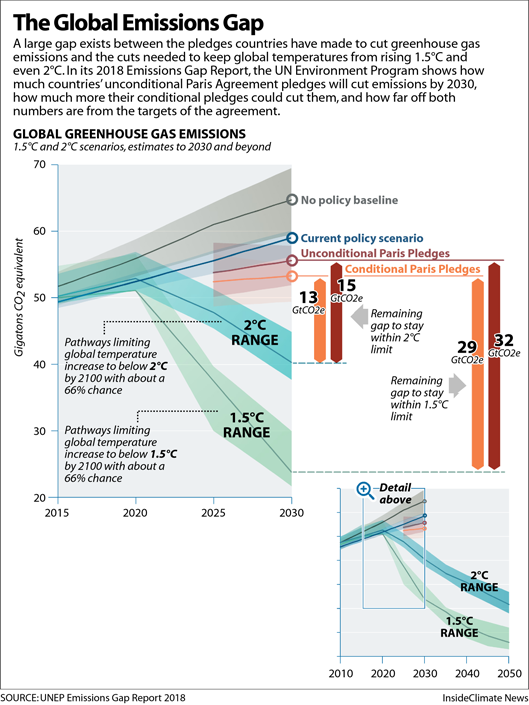Relevance: Prelims/Mains: G.S paper III: Environment
Context
The 2019 UN Environment Programme (UNEP) Emissions Gap Report paints a “bleak” picture of accelerated global greenhouse gas (GHG) emissions and a growing gap between “what we need to do and what we are actually doing to tackle climate change.”
About
- This is the tenth edition of the United Nations Environment Programme (UNEP) Emissions Gap Report.
- It provides the latest assessment of scientific studies on current and estimated future greenhouse gas (GHG) emissions and compares these with the emission levels permissible for the world to progress on a least-cost pathway to achieve the goals of the Paris Agreement.
- This difference between “where we are likely to be and where we need to be” has become known as the ‘emissions gap’.
What is the “Emissions Gap”?
- The Emissions Gap could also be called the “Commitment Gap”.
- It measures the gap between what we need to do and what we are actually doing to tackle climate change.
- The gap is the difference between the low levels of emissions that the world needs to drop to, compared with the projected level of emissions based on countries’ current commitments to decarbonisation.
Why does the Emissions Gap Matter?
- The gap is important because if we can’t close it and meet the emissions reduction target, we will face increasingly severe climate impacts worldwide.
- It is important that policymakers, and their citizens, know what the gap is so that the commitments countries are making are sufficient to close the gap.
What does the Emissions Gap Report measure?
The Emissions Gap Report measures and projects three key trend lines:
- The amount of greenhouse gas emissions every year up to 2030
- The commitments countries are making to reduce their emissions and the impact these commitments are likely to have on overall emission reduction
- The pace at which emissions must be reduced to reach an emission low that would limit temperature increase to 1.5oC, affordably.
The key “headline” messages and conclusions of the report
- GHG emissions continue to rise, despite scientific warnings and political commitments;
- To close the emissions gap by 2030, annual emissions need to be 15 GtCO2e lower than current unconditional NDCs imply for the 2°C goal, and 32 GtCO2e lower for the 1.5°C goal;
- Enhanced action by G20 members will be essential for the global mitigation effort. Collectively, G20 members – who account for 78% of global GHG emissions – are on track to meet their limited 2020 Cancun Pledges, but seven countries are currently not on track to meet their 2030 NDC commitments.
- “Dramatic strengthening” of the NDCs is needed in 2020. Countries must increase their NDC ambitions threefold to achieve the “well below 2°C” goal and more than fivefold to achieve the 1.5°C goal.
- Although the number of countries announcing net zero GHG emission targets for 2050 is increasing, only a few countries have so far formally submitted long-term low-emission development strategies to the UNFCCC.
- Decarbonising the global economy will require fundamental structural changes, which should be designed to bring multiple co-benefits for humanity and planetary support systems.
- Renewable and energy efficiency, in combination with electrification of end uses, are key to a successful energy transition and to driving down energy-related CO2 emissions.
- Demand-side material efficiency offers substantial GHG mitigation opportunities that are complementary to those obtained through an energy system transformation.
For more such notes, Articles, News & Views Join our Telegram Channel.
Click the link below to see the details about the UPSC –Civils courses offered by Triumph IAS. https://triumphias.com/pages-all-courses.php


